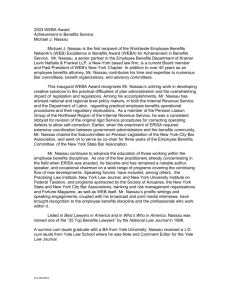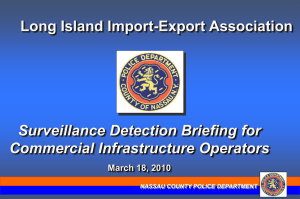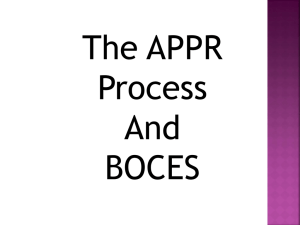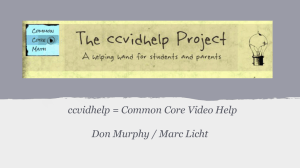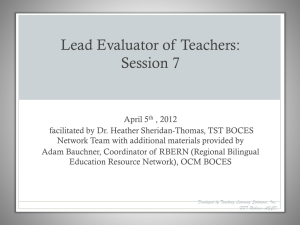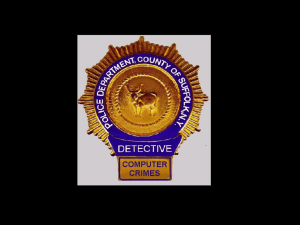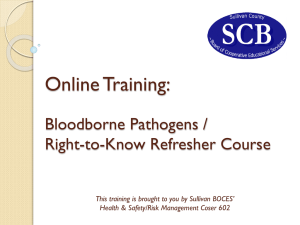Data Driven Instruction: Inquiry Teams
advertisement
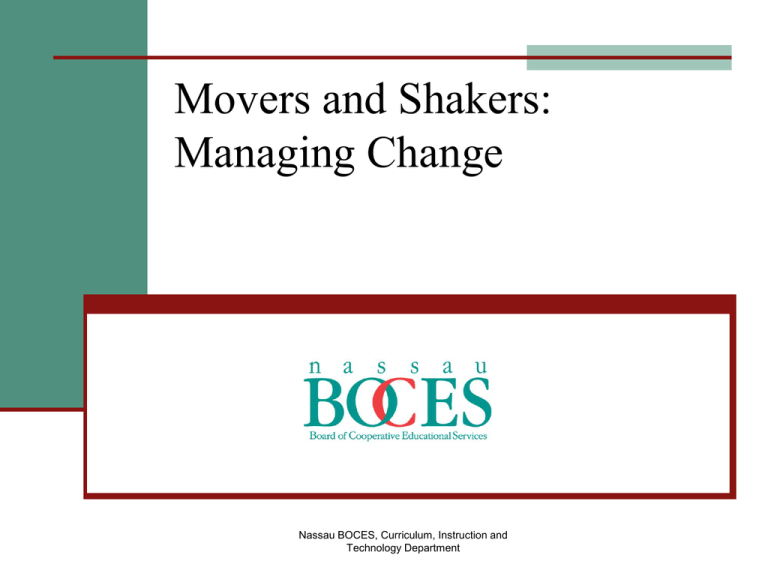
Movers and Shakers: Managing Change Nassau BOCES, Curriculum, Instruction and Technology Department Data Driven Instruction: Inquiry Teams Presented by Tim Dolan Elaine Zseller, Ph.D. Edited from NYSED DDI Conference 11/03/11 Nassau BOCES, Curriculum, Instruction and Technology Department RTTT – Three-Legged Stool What do students need to know? Common Core How do we know they learned? Data Driven Instruction How do we know students received good instruction? Teacher Evaluation Nassau BOCES, Curriculum, Instruction and Technology Department RTTT – Change outcomes – What does this data seem to say? 100% Pct. Proficient 90% 80% 70% 60% 50% 40% 30% 20% 10% 10% 20% 30% 40% 50% 60% Pct. Free-Reduced Lunch Nassau BOCES, Curriculum, Instruction and Technology Department 70% 80% 90% 100% RTTT - Word Meanings What do the following words mean to you? Rigor Mastery Alignment Nassau BOCES, Curriculum, Instruction and Technology Department Man on Fire – Creasy and Pita What were the strengths of Creasy as an instructor? Nassau BOCES, Curriculum, Instruction and Technology Department DDI – Insights from Man on Fire • If you’re not at the pool, you cannot do the • • • • • analysis Relationships matter Creasy went from “what” was wrong, to “why” The practice targeted the exact problem The practice simulated the real event They set a specific goal that they could track Nassau BOCES, Curriculum, Instruction and Technology Department Change and Data - Moneyball Nassau BOCES, Curriculum, Instruction and Technology Department Moneyball (Clip 1): How did Billy Beane change tradition? What is Billy Beane doing differently than his peers? What are key ideas or insights that connect to the work you are currently undertaking? What about his tactics makes others uncomfortable? Who is it making uncomfortable? Nassau BOCES, Curriculum, Instruction and Technology Department How did Billy Beane change tradition? •http://www.youtube.com/watch?v=R8RXPRfhmA8 Nassau BOCES, Curriculum, Instruction and Technology Department Moneyball: How did Billy Beane change tradition? What is Billy Beane doing differently than his peers? What are key ideas or insights that connect to the work you are currently undertaking? What about his tactics make others uncomfortable? Who is it making uncomfortable? Nassau BOCES, Curriculum, Instruction and Technology Department Moneyball (Clip 2): : How is data used to identify player’s strengths? How does Billy Beane use data differently to identify player strengths? What are key ideas or insights that connect to the work you are currently undertaking? Nassau BOCES, Curriculum, Instruction and Technology Department Moneyball: How is data used to identify player’s strengths? http://www.youtube.com/v/WNlCBy07z08 Nassau BOCES, Curriculum, Instruction and Technology Department Moneyball: How is data used to identify player’s strengths? How does Billy Beane use data differently to identify player strengths? What are key ideas or insights that connect to the work you are currently undertaking? Nassau BOCES, Curriculum, Instruction and Technology Department Managing Change Nassau BOCES, Curriculum, Instruction and Technology Department Switch (Clip 1) - Managing Change Is change hard or easy? What’s the 2nd biggest life change that Americans reported on a recent survey? Would you guess people resisted this change or volunteered for it? Why did you choose a career in education? What does the leader of change need to do? (Switch, Chapter 1, section 3) Nassau BOCES, Curriculum, Instruction and Technology Department Switch – Part 1 http://vimeo.com/12561213 Nassau BOCES, Curriculum, Instruction and Technology Department Switch - Managing Change Is change hard or easy? What’s the 2nd biggest life change that Americans reported on a recent survey? Would you guess people resisted this change or volunteered for it? Why did you choose a career in education? What does the leader of change need to do? (Switch, Chapter 1, section 3) Nassau BOCES, Curriculum, Instruction and Technology Department Switch (Clip 2) - Managing Change: How do you make change manageable? What made change difficult in Vietnam? What data led to change? What needed to be done to create change? How does this relate to your work? Nassau BOCES, Curriculum, Instruction and Technology Department Switch – Part 2 http://player.vimeo.com/video/12565075 Nassau BOCES, Curriculum, Instruction and Technology Department Switch - Managing Change: How do you make change manageable? What made change difficult in Vietnam? What data led to change? What needed to be done to create change? How does this relate to your work? Nassau BOCES, Curriculum, Instruction and Technology Department Managing Change (Switch, Chapter 1, Section 4) What are the characteristics of the elephant? What are the characteristics of the rider? Nassau BOCES, Curriculum, Instruction and Technology Department Direction must be known Who decides the path? (Switch, Section 8) Nassau BOCES, Curriculum, Instruction and Technology Department Three-Part Framework 1. Direct the Rider: What looks like resistance is often a lack of clarity. Provide crystal-clear direction. 2. Motivate the Elephant: What looks like laziness is often exhaustion. Engage people’s emotional side. 3. Shape the Path: What looks like a people problem is often a situation problem. When you shape the situation or “path” you make change more likely. Nassau BOCES, Curriculum, Instruction and Technology Department The best glove Read Switch, Section 6 -7 How does this apply to instruction? Nassau BOCES, Curriculum, Instruction and Technology Department Action Plan What two steps should your district take next? Nassau BOCES, Curriculum, Instruction and Technology Department Sharing Protocol (Groups of 3; 5 minutes per presenter) 1. Presenter - shares salient aspects of their action plan (3 mins) 2. Critical Friends - Ask clarifying questions [presenter responds] (2 mins) 3. Critical Friends - Discuss warm observations [presenter doesn't participate] (2 mins) 4. Critical Friends - Give cool observations [presenter doesn't participate] (2mins) 5. Critical Friends - Discuss probing/ deep questions/ next steps [presenter doesn't participate] (5 mins) 6. Presenter - responds/ reacts/ names next steps (1 min) Nassau BOCES, Curriculum, Instruction and Technology Department Thank you for attending! Tim Dolan 608 – Tdolan@mail.nasboces.org Elaine Zseller, Ph.D. 608-6618 ezseller@mail.nasboces.org Nassau BOCES, Curriculum, Instruction and Technology Department
